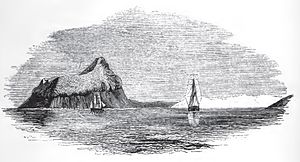Cockburn Island (Antarctica)
| Cockburn Island | ||
|---|---|---|
| Cockburn Island with HMS Erebus and HMS Terror | ||
| Waters | Weddell Sea | |
| Archipelago | Ross Islands | |
| Geographical location | 64 ° 12 ′ 0 ″ S , 56 ° 51 ′ 0 ″ W | |
|
|
||
| length | 2.8 km | |
| width | 1.8 km | |
| surface | 4 km² | |
| Highest elevation |
Cockburn Peak 450 m |
|
| Residents | uninhabited | |
The Cockburn Island ( English Cockburn Island ) is a small island south of the northeastern tip of the Antarctic Peninsula in the Weddell Sea .
geography
Cockburn Island is at the exit of Admiralty Road into the Erebus and Terror Gulf . It is only 3.5 km from Bodman Point on Seymour Island and about 12 km from Cape Gage on James Ross Island . The island has an oval shape. Its 250 m high plateau drops steeply into the sea on all sides. The island reaches its highest point in a conical elevation in the west of the plateau.
geology
The cone-shaped Cockburn Peak and Plateau are formed by tuff and hard basalt , which preserved the softer sediments below from erosion and which is responsible for the current shape of the island. In the eastern part of the plateau, the volcanic rocks are covered by the fossil-rich sandstone of the Cockburn Island Formation, which is 2.5 to 3 million years old. On the steep cliffs , rocks from the Cretaceous (Snow Hill Formation) and the Eocene (La Meseta Formation) emerge under the basalt .
climate
The climate on Cockburn Island is cold and dry. There is no longer series of measurements, but it can be assumed that it hardly differs from that of the Marambio station on Seymour Island, 15 km away . Here the mean temperature over the year is −9.1 ° C, in December, the warmest month, it is −1.7 ° C and in July, the coldest month, it is −15.2 ° C. The strong winds and low rainfall ensure that the surface of the island is mostly free of snow.
Flora and fauna
A first inventory of the vegetation on Cockburn Island was made in 1843 by Sir Joseph Dalton Hooker , who collected plants south of the South Shetland Islands for the first time here . The harsh climatic conditions prevent the growth of higher plants, but nine types of moss , 34 types of lichen , three types of cyanobacteria and one type of algae were found.
Cockburn Island is designated as an Important Bird Area (AQ071) by BirdLife International . In 2006, 800 breeding pairs of the blue-eyed shag were counted. Hooker also found breeding colonies of the Adélie penguin and the snow storm here in 1843 . It is not known whether these birds still breed on the island today.
history
Cockburn Island was discovered by James Clark Ross in 1843 and named after the British naval officer Sir George Cockburn . It is the only place in West Antarctica that Ross entered on his journey. Ross' occupation of the island for the British Empire on January 6, 1843, is now used by Great Britain as a basis for its claims to the islands east of the Antarctic Peninsula.
Only in 1902 was the island re-entered by members of the Swedish Antarctic Expedition , led by Otto Nordenskjöld . Nordenskjöld spent the winter on Snow Hill Island within sight of Cockburn Island. Gösta Bodman (1875–1960) was the first to climb the island's plateau. In 1903 Johan Gunnar Andersson found fossils from the Cretaceous and the Tertiary .
In 1945, exploration of the island was resumed. As part of Operation Tabarin , Cockburn Island was geologically investigated by WN Croft. In the following years it was mainly Argentinian, British and Polish geologists and paleontologists who visited the island.
Individual evidence
- ^ William J. Zinsmeister, Peter-Noel Webb: Cretaceous-Tertiary geology and paleontology of Cockburn Island . In: Antarctic Journal of the United States 17, 1982, pp. 41–42 (English)
- ↑ Jeffrey D. Stillwell: Geological exploration of Cockburn Island, Antarctic Peninsula (PDF; 496 kB). In: Polish Polar Research 23 (1), 2002, pp. 47–73 (English)
- ^ A b c R. I. Lewis Smith: The vegetation of Cockburn island, Antarctica . In: Polar Biology 13 1993, pp. 535-542 (English)
- ^ Joseph Dalton Hooker: The botany of the Antarctic voyage of HM discovery ships Erebus and Terror in the Years 1839-1843 under the command of Captain Sir James Clark Ross . Volume 1: Flora Antarctica . Reeve Brothers, London 1844–1847 ( online , English)
- ↑ Cockburn Island (AQ071) in the Data Zone at BirdLife International, accessed on July 22, 2018 (English).
- ↑ James Clark Ross: A Voyage of Discovery and Research in the Southern and Antarctic Regions during the years 1839-43 . Volume 1, Murray, London 1847, p. 342 (English)
- ^ William James Mills: Exploring Polar Frontiers - A Historical Encyclopedia . tape 1 . ABC-CLIO, 2003, ISBN 1-57607-422-6 , pp. 102 ( limited preview in Google Book search).
- ↑ Rodney M. Feldmann: Recent advances in the systematics and distribution of fossil lobsters from the Cretaceous and Paleocene of James Ross Basin, Antarctica . In: Antarctic Journal of the United States 23, 1989, pp. 40–41 (English)

